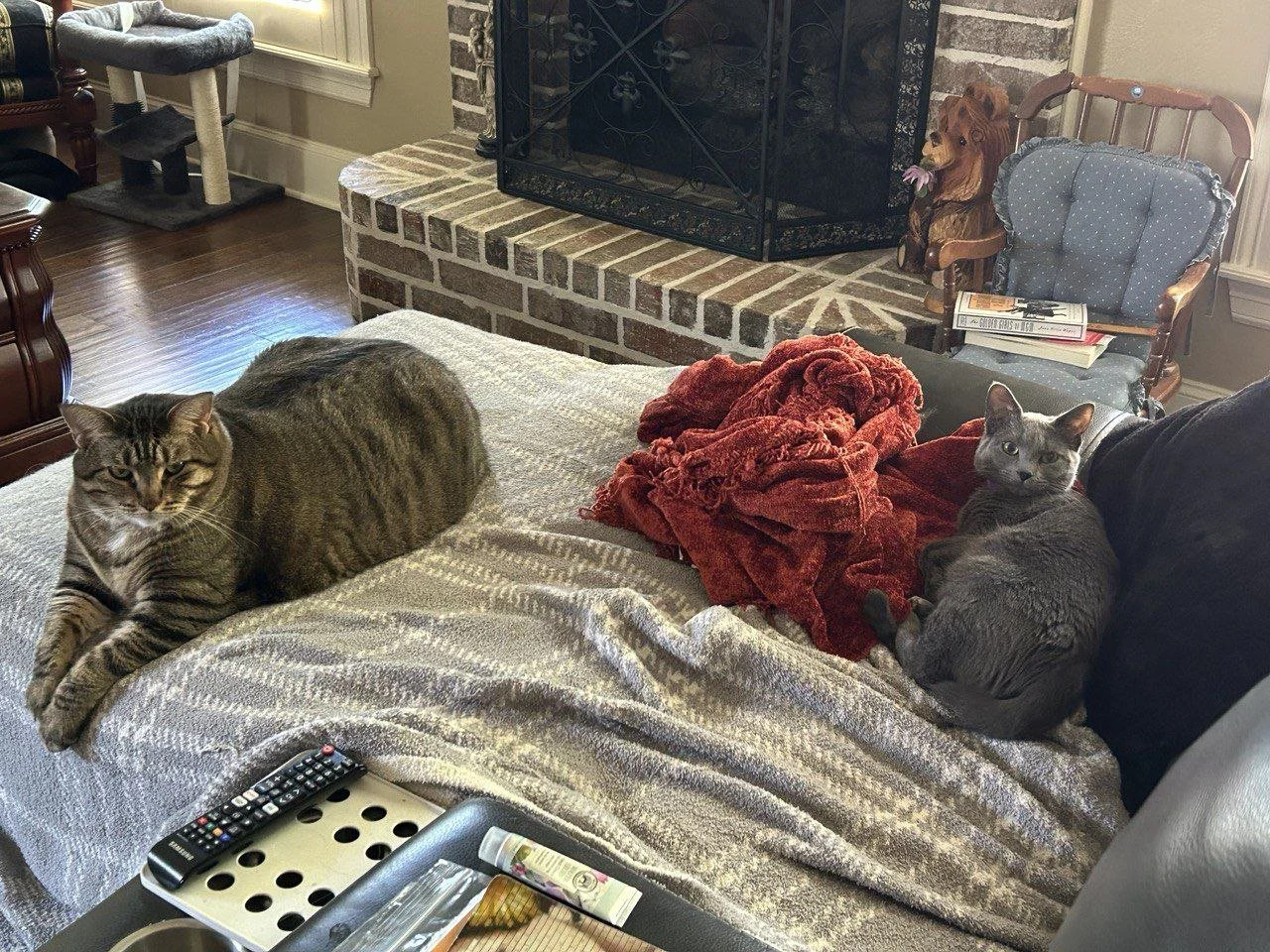Got your attention yet?
FAT CAT PROJECT
Project Type
Personal real- life product design experiment
My Role
Research, product prototyping, and design
Results
Successfully de-chonked a determined glutton.
Background: The Chonk Problem
When a new kitten, Gracie, was introduced into a home ruled by an already hefty cat, Moscow, a unique challenge surfaced. Moscow, who had always been on the "chonky" side, transformed into a “mega chonk,” surpassing the chonker chart entirely. What started as an accidental weight gain soon turned into a personal product design experiment to resolve a growing problem.
Understanding the Two Eating Styles
I quickly realized that the household was divided by two distinct eating behaviors:
GRAZERS
These are cats that can be trusted with food in their bowl. They nibble throughout the day, eating little bits until satisfied. A bowl filled for a grazer may last up to three days, as they have the self- control to pace themselves.
VS
GLUTTONS
These cats lack the willpower to resist a full bowl. They'll eat every morsel in one sitting and still beg for more by day's end. Portion control is a necessity in their world.
In a household with two adult grazers or two adult gluttons, things run smoothly. But combining a grazing kitten like Gracie with a glutton like Moscow?
Chaos.
Moscow began devouring both her food and Gracie's, leading to rapid weight gain.
Meet the Cats
Gracie: A 6-month-old kitten who needs multiple small meals throughout the day.
Moscow: A 5-year-old cat who once weighed 23 pounds and ballooned to 27 pounds after "helping" herself to Gracie's meals.
The Problem
Leaving food out for Gracie was no longer an option, as Moscow would swoop in and finish everything. After numerous failed attempts to "hide" food in places only an agile kitten should access, I turned to my design skills. How could I ensure Moscow wouldn't eat Gracie’s food when no one was around to supervise?
Market Research
I found existing solutions for this problem—chip-activated feeders that kept one pet's food out of reach of another. However, they came with a hefty price tag, averaging $350 for two feeders. That was far too expensive for the average pet owner.
I needed an affordable solution that would keep glutton Moscow from accessing grazer Gracie’s food while also accommodating different nutritional needs.
Ideation: Pain Points
Affordability: The solution had to be budget-friendly.
Nutritional Needs: Both cats had different dietary requirements.
Supervision: The system needed to work without someone always watching.
Unboxing Ideas
The initial idea was simple: take advantage of the size difference between Moscow and Gracie. If I created a small entryway, just big enough for Gracie, but too small for Moscow, problem solved.
Prototype 1: The Cardboard Box
The first prototype involved a cardboard box with a small "Gracie-sized" entrance.
This kept Moscow from reaching Gracie's food, but there was a new problem—Gracie was eating in darkness.
How to bring light into the box?
To fix this, I made slots in the box for light to come through. However, this made the box flimsy, allowing Moscow to jump on and crush it.
We also discovered that Moscow had a taste for cardboard. She gnawed on the box, determined to get to the food inside. Clearly, cardboard wasn’t a viable long-term solution.
Prototype 2: Plastic Storage Container
Next, I turned to clear plastic storage containers with removable lids. I modified the box by cutting a small entry port just big enough for Gracie. This worked perfectly.
The clear material let light in, and the hard plastic was durable enough to withstand Moscow's attempts to bulldoze her way through.
Clear plastic storage containers meet a determined cat mom with a knife
To prevent Moscow from opening the lid (she had figured out how to pop open push-latch boxes), I chose containers with locking latches that only human hands could operate.
Solution Achieved!
Success! Gracie had access to her food, while Moscow was left staring at the six measly kibbles just out of reach.
Results?
After three months of using the plastic-box system, Moscow slimmed back down to her original 23-pound weight. She was then put on a new diet to continue her journey toward a healthier weight.
Refining the DIY Product
Refining the DIY Product
Though the plastic box worked, I began to consider how this DIY solution could be turned into a more polished, marketable product
Serrated plastic that can be cut out for customization
Needs to be strong enough so fat cats can’t just bulldoze through
Larger serrated cuts to increase strength of plastic opening
A padded cushion rim for soft entry way, not made with code preferably actual foam
Removing the lawsuit with the introduction of the heated tool?
Large heated tip tool with curved top the size of the openings?
No, too expensive and defeats affordability.
Just add a flat head screw driver that comes with a lighter too the box?
Too DIY.
Small flat head shaped tool with heating heat
Affordable, and more professional
Conclusion
The Fat Cat Project started as a way to manage Moscow’s weight and evolved into a creative exploration of affordable, practical pet design. Through multiple prototypes and iterations, I found a solution that worked for both gluttons and grazers alike—proving that even the chunkiest of cats can be de-chonked with a little ingenuity.






















